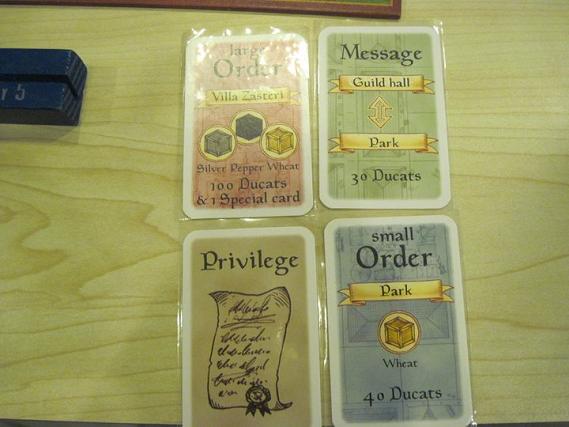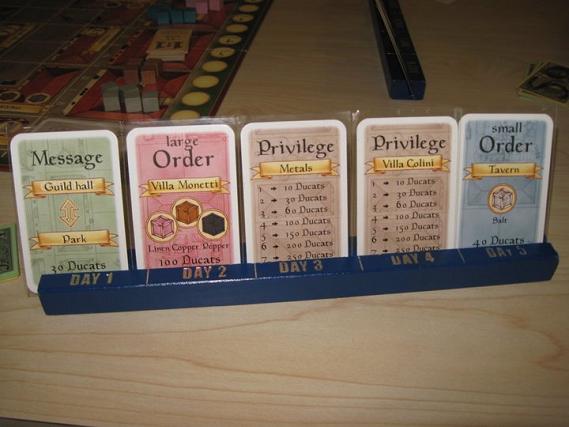
Sean suggested that we play some negotiation games after we playtested a very simple prototype that I recently whipped up. The prototype had some negotiation elements but was so free-form that no one bothered to initiate any deals. I realized from the experience that you need at least some structure to limit the possibilities or otherwise the options become so daunting that no one ever wants to initiate anything. The Traders of Genoa is one of these negotiation games, and as expected, despite allowing players to negotiate for almost anything, its structure ensures that deals are done in a timely and orderly fashion.
As befits its name and its focus on trading, The Traders of Genoa has the players acting as merchants and the object of the game is simply to have the most money. The game last for a fixed number of rounds, the exact number depending on the number of players, though a random event may cause one or more rounds to be skipped. During each round, each player gets a turn though players also have opportunities to purchase actions when it is not their turn. The amount of money owned is secret information throughout the game. At the end of the last round, everyone reveals how much they have and the players are ranked accordingly.
The board is a 8×8 grid of squares. Some of these spaces represent buildings. Others represent street areas. Each building has a unique action associated with it. Streets don’t offer any actions but if any players have any ownership markers, moving through street areas offers them an opportunity to own adjacent buildings. Each player starts the game with the same amount of money and one of each of the four cards that represent the primary method of earning money. These are as follows:
- The Large Order cards which require the player to deliver three different goods to a specific location. The reward for completing it is a large amount of money and a Special Card of the player’s choice.
- The Small Order cards which require the player to deliver one specific good to a specific location in exchange for a moderate amount of money.
- The Message cards which give the player a small amount of money if anyone travels from one of the named locations on the card to the other.
- The Privilege cards which gives its cash reward only at the end of the game. Each one depicts one of the 14 buildings on the edge of the board. Owning sets of these cards representing chains of adjacent buildings increases the reward.

The key mechanic in the game relates to the five round wooden tokens. At the beginning of each player’s turn, he rolls two dice to determine a random location on the board. All five of the wooden tokens are then stacked there. The active player may move by taking tokens and placing them orthogonally adjacent to its original location. This allows the player to move a maximum of four spaces away. For each token that is placed on a building, that building’s action is available to be taken. The catch however is that each player can normally only take one action per turn. So while there are potentially five actions available in a turn (which is unlikely as the tokens must often pass through a street area), the active player may take only one of them. The rest must be sold to the other players, which is where all the wheeling and dealing comes in.
There are a few rules governing negotiations but they’re pretty intuitive. First, all the other players deal with the active player on a one-on-one basis, instead of it being a free-for-all. This makes things a lot less confusing. Secondly, others players may propose any sort of deal to the active player but the only sort of deal that is binding is the one relating to the next placement of the wooden tokens. So I could tell the active player that I’m willing to pay for action two spaces away, but I can’t actually hand over any money and he doesn’t actually have to do what I say when push comes to shove. But if the Palace space is just one move away, I could say that I’d pay him 30 Ducats for the Palace action and if he agrees, he must place a token there and give the action to me. Once again, reducing the scope of possible deals simplifies things a great deal.
Finally any thing can be offered between the active player and other players as part of a deal. This includes money, any type of card, goods cubes, ownership markers, actions, anything. In our session, we paid for actions mainly with cash, but Hiew, who the one player focused on collecting the Privilege Cards, made deals with them as the sweetener. In the last turn of the game, Hiew even made a deal with me just for the purpose of buying my Privilege Cards and was uninterested in the action itself.

Exhaustively listing the various building actions would take too long so I’ll just give some examples. There are four warehouses and each of them allows the player executing their associated action to take one cube each of the two type of goods on offer there. This means that there are a total of eight types of goods in the game. Each of the four types of cards described above has at least one building associated with them, so you can go there to draw more of them. Other buildings allow the player to take one of the Special Card tiles which can be spent to break the rules in specific ways. One of these tiles allows the active player to start at any location instead of rolling dice. Another one gives a player an extra action for the turn. Yet another one can be spent to turn in one of any type of resource for one of any other type.
Finally a few more rules before we’re done. If a player starts in the center space of the board, one round is skipped, bringing the game closer to its end. At the end of each turn, any players with ownership markers (gained from the Cathedral building) may remove one of the round wooden markers from a street space to place ownership makers on any adjacent buildings or to spend one marker to remove the marker of another player. If someone else uses an action at a building you own, you earn 10 Ducats from the bank.
Anyway, I quite enjoyed this game which I didn’t expect given how poor my social skills are. Shan however hated it. She likes games that are coldly analytical and doesn’t like negotiation. I suspect that Sean’s reasons for disliking negotiation games are also similar. Sean is probably also disadvantaged in such games for meta-gaming reasons. Since he’s perceived as a skilled player, other players tend to demand more from him to come to a deal. I exploited this several times in our game, as I knew that Shan and Choo were likely to agree to my deal in preference to Sean’s even if both of us offered the exact same terms.
A few more personal observations:
- Everyone was hesitant about prices for actions at the beginning but we arrived at a standard price for various types of actions remarkably quickly. After all, the value of most types of resources is pretty objective and transparent most of the time. I note that we probably undervalued the Cathedral action, especially at the beginning of the game and because Sean explained the rules for the Warehouses wrongly, this skewed our relative perception of values for resources such as goods, the Any Ware tile and the Large and Small Order cards.
- Since the value of these resources is more or less computable in advance, the next most important consideration is the relative wealth of the players. That money is hidden information is obviously meant to complicate what is otherwise a very straightforward deliberation. But I think the game slips up slightly in this regard as it is simply impossible to keep track of how much money each player has. Everyone knew that Hiew would more or less be in front due to the Privilege Cards he had, but we also thought that Sean was in second place as we had seen him complete many orders. It turned out that he had paid too much to complete them as he had the least amount of money by far. Hiew also grossly underestimated how much money I had by far in making the final deal with me.
- A compromise I would suggest would be to implement something similar to Dschunke, forcing everyone to declare how much money they have at a couple of predetermined points in the game. Without this information, we end up making decisions in a vacuum.
- I think all of us underestimated just how powerful the 1:1 exchange special card was, but that was also partly because we overvalued the goods cube due to only taking one of them at a time. Imagine how useful it would be to take two goods cubes with one action and exchanging one of them for a Large Order card, a Privilege Card or even a building ownership marker!
- All that said, there’s still quite a bit of luck in the game. The randomness of your starting location matters. So does which Message cards you manage to draw. It’s not a huge factor but it’s there.
Overall, I find this to be an excellent game though I’m curious about what happens when everyone is an experienced player and knows how to properly evaluate the value of the various actions and resources. It’s certainly one of most memorable sessions I’ve had in a while, ending as it did with the huge deal between Hiew and myself. I think Hiew will write about that extensively so I’ll just say that for my part, I suspected that a deal would be possible from the moment I declined Hiew’s earlier offer for the Privilege Card action and took it for myself. I was however shocked by how much he was willing to pay. It’s cool that a game can be decided by one huge deal in this way, but I do find it annoying how everyone is just guessing how much money we each had and as it turned out, everyone guessed wrongly.
One Response to “Traders of Genoa”
Trackbacks
Leave a Reply